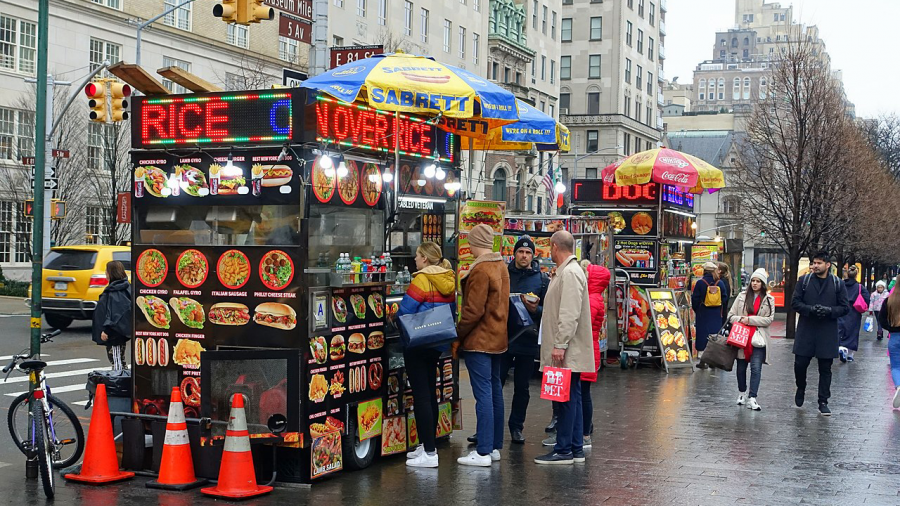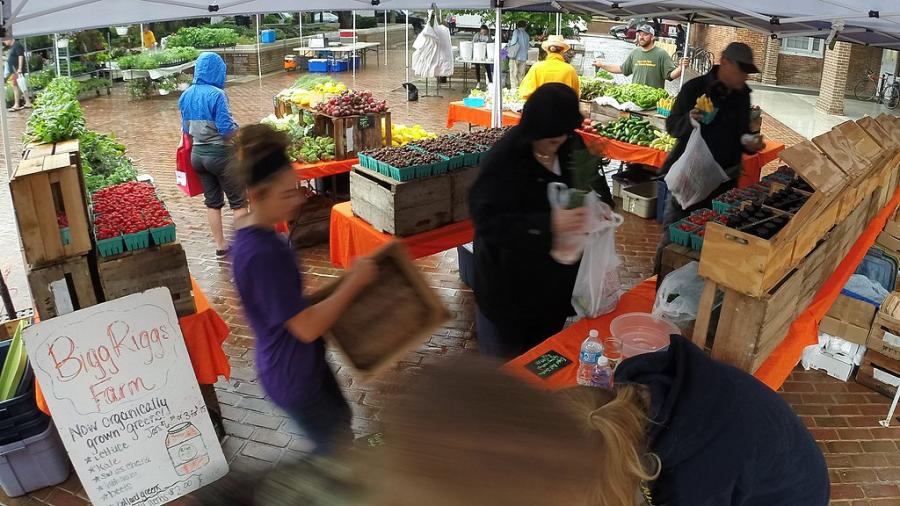
A downloadable version of this lesson is available here:
The United Nations (UN) has established 17 Sustainable Development Goals (SDGs) that broadly address the critical interdependencies between human well-being and environmental health. These goals include such human-centered priorities as poverty, hunger, education, job opportunity, and gender equity, as well as environmental concerns like climate change, freshwater quality and quantity, and the health of aquatic and terrestrial ecosystems. Of course, none of these goals exists in a vacuum. For example, poverty is linked to education, jobs, gender equity, and several elements of environmental health. Fortunately, we can target progress in singular UN SDGs by understanding how their causation emerges from a complex blend of socio-environmental factors. This lesson will begin that work by delving into the theory and science around urban agrobiodiversity: the variety and quality of food products made available to city dwellers across the globe. Better systems of food production, distribution, diversity, and inclusive cultural representation have the power not only to increase nutrition standards for city dwellers but also to cohere and make progress toward other related UN SDGs like sustainable cities, reduced inequality, and decent work and economic opportunities. When food producers follow sustainable guidelines for smart land and water use and reduce harmful inputs of artificial fertilizer and pesticides, urban agrobiodiversity also solves environmental challenges. Learners will research and propose creative intersections among the UN SDGs to envision more equitable and sustainable urban agrobiodiversity outcomes by the mid 21st century.
- Learn and consider 17 Sustainable Development Goals identified by the UN and integrate these goals with new linkages and theory in urban agrobiodiversity.
- Research and detail existing initiatives in urban agrobiodiversity in your city, align them with the SDGs, and develop ways to support and amplify these initiatives by 2030.
- Integrate four key agrobiodiversity linkages with social benefits related to environmental justice, including gender equality, optimal nutrition, economic opportunity for disadvantaged groups, and improvements in the sustainability and health of urban habitat.

Ask all learners to spend 2 minutes as a full group to brainstorm and list the food-access options in your local region. These may include grocery stores, restaurants, corner stores, gas stations, farmer’s markets, Community Supported Agriculture (CSA) providers, food trucks, ethnic and specialty groceries, community gardens, and direct-sale farms. Then, next to each site of food sourcing, estimate the level of food diversity and quality available at that site on a scale from 1 to 5. For example, a fast food restaurant or a standard gas station would score low on the diversity/quality scale, whereas an ethnic specialty grocer or a CSA might score high. Have each learner write down a few personal observations of how they navigate the interfaces among food quality and variety versus convenience and affordability. What’s one key intervention, or food-buying opportunity, that would most increase the quality and variety of the food they can access? List these ideas in a space learners can view, such as the online course discussion board.
Advancing Sustainable Development Goals: Urban Agrobiodiversity (One 75-minute class)
-
As preparation for class, have learners read and take notes on the article by Zimmerer et al (2021), paying special attention to the highlighted portions. Learners should also review the 17 UN Sustainable Development Goals for an overview of the areas of action and intersections among these broad goals.
DocumentZimmerer et al. 2021 – Highlighted.pdf (2.71 MB) -
(10 min.) Review the major concepts of sustainable development and urban agrobiodiversity using these lesson PPT slides.
Document -
(5 min.) Zimmerer et al. identifies four major linkages among urban agrobiodiversity development strategies. These will become four focus groups for learners to develop conceptual plans to achieve greater urban sustainability. Assign each learner to a focus group, or allow individuals to choose their area, provided that each of these four foci is covered by at least a few collaborative learners. The learners should use the nearest large city as their model and case study to apply the following linkages:
- Urban and peri-urban land use: local and regional agriculture to supply urban food
- Urban food supply chains: medium and long-distance supply to enhance quantity and variety
- Urban food access: economic and cultural factors that affect access to varied and nutritious food
- Urban food retailing: point-of-sale opportunities to affordable, varied, and nutritious foods
-
(5 min.) First, have each group review the 17 UN SDGs. Have them highlight at least three to four SDGs that the development of their group’s agrobiodiversity linkage may support. For example, the “food access” group might conclude that enhancing economic and cultural diversity in urban food pathways also supports SDGs #2 (zero hunger); #3 (good health and well-being); #5 (gender equality); #8 (decent work and economic growth); #10 (reduced inequality); #11 (sustainable cities and communities), #12 (responsible consumption and production), #16 (peace, justice, and strong institutions); and #17 (partnerships for the goals). Have the group suggest one to two ways that their linkage might support each related SDG.
-
(15 min.) With the specific city, agrobiodiversity linkage, and related SDGs now defined for each group, ask them to research the existing infrastructure, resources, and opportunities related to their intersectional focus. Have groups highlight two to three ideas that might be implemented by 2030. (Their research should result in a short [5-min.] presentation on findings, ideas, gaps, and remaining questions.)
Land use groups should look at land use maps and research local agriculture and community garden programs that may enhance their city’s local agrobiodiversity.
Supply chain groups may review the current state and future of our national food supply chains. The USDA recently published a new framework for a more resilient and equitable food supply chain, which gives a background on the issues related to long-distance food sourcing.
Food access groups should research their city’s demographics and socioeconomics, dependence on food assistance and resources for food insecure groups, as well as cultural and ethnic characteristics that enhance food diversity.
Food retailing groups should review maps of the accessibility and variety of food purchase options, perhaps reviewing local maps of retail stores and markets, as well as information compiled from the "Hook."
-
(20 min.) Now have the groups present their findings in 5 minutes and invite discussion of additional lacunae of research or gaps in data or accessibility. That is, what were they able to find, and what more information would they need to design solid guidance on the city’s best practices related to agrobiodiversity? As each group presents, the instructor should compile information that will assist the learners in generating a summary document on the state of the four linkages in their city.
-
(10 min.) Review the associated SDGs for each linkage and see how many of the 17 goals are at least tangentially related to one or more agrobiodiversity linkage. This exercise should reveal how SDG are interrelated with urban agrobiodiversity. It may also show how some of them are in conflict with the historic, normative, and problematic food cultures that persist in our cities (industrial, monoculture, low-nutrition, fast food, inequitable distribution, gentrification).
-
Optional Extension: Learners may extend this inquiry by developing an in-depth analysis that further synthesizes their city’s agrobiodiversity and sustainable development initiatives and potential. This individual or group project would involve integrating this session’s group findings with further research and reporting on how the target city could grow its food and sustainable development offerings with a target date of 2030. Learners could identify appropriate city officials to submit their findings to, and use their college or university’s outreach team to lend authority and exigency to their report. Alternatively, figuring the university as a “city” of its own, their report could focus on the on-campus needs and potentials, with a report submitted to university administrators and food services directors.
-
Operationalizing Sustainable Development to Benefit People and the Planet
This in-depth report, from the National Academies of Sciences, Engineering, and Medicine, identifies key research priorities and actionable steps to operationalize sustainable development at the global and local levels. It draws on global case studies, research papers, and committee members’ experience to outline eight research priorities and actionable steps in achieving SDGs, despite global challenges caused by the COVID-19 pandemic, increasing levels of conflict, and rising challenges caused by climate change.
National Academies of Sciences, Engineering, and Medicine. (2022). Operationalizing Sustainable Development to Benefit People and the Planet. Washington, DC: The National Academies Press. https://doi.org/10.17226/26654
-
Can nature deliver on the sustainable development goals?
This brief opinion piece interrogates the interdependence between the UN’s social SDGs and the state of global ecosystems that support human well-being. It uses local forest cover as a factor in impoverished children’s incidence of common ailments: diarrhea, stunting, and anemia.
Fisher, B., Herrera, D., Adams, D. et al. (2019). Can nature deliver on the sustainable development goals? Lancet, 33, e112-e113. https://doi.org/10.1016/S2542-5196(18)30281-X
-
International Institute for Sustainable Development (IISD)
This think tank identifies strategic priorities and work areas; provides reports, analysis, and explainers; and aligns global biodiversity and ecosystem health with human SDGs.
International Institute for Sustainable Development (IISD). (n.d.). Home page. https://www.iisd.org
-
Nations United: Urgent Solutions for Urgent Times
This 30-minute film articulates the UN SDGs in the context of ongoing global struggles with climate change, violent conflict, disparities in wealth and gender rights, and loss of biodiversity.
United Nations. (2020, September 19). Nations United: Urgent Solutions for Urgent Times [Video]. YouTube. https://www.youtube.com/watch?v=xVWHuJOmaEk&t=20s